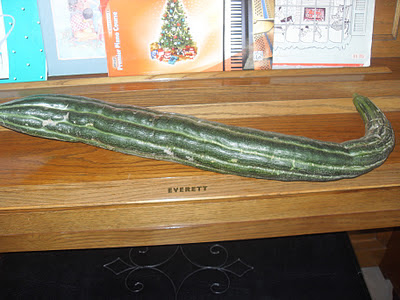 |
| Ready to remove seeds of fully grown Armenian Cucumber |
Should you say the words “Armenian Cucumber” to gardeners in Tucson you usually get one of two responses. Either they love it or they hate it. And if they hate it this is often because they pick it when it is too big. The Armenian cucumber is the “zucchini” of the melon family. As the cucumber grows its flesh turns from a tender zucchini-cucumber taste to something reminiscent of the crunch of a carrot and the taste of a watermelon rind. It has a light green color and smooth skin that can be eaten raw and has furrowing (or ridging) along the length of the cucumber. Though it is botanically a melon (C. melo) like a cantaloupe or a honeydew it is used like a cucumber because it tastes like one when it is the size of one.
 |
| A young Tender Armenian Cucumber |
So why do people grow the Armenian Cucumber instead of other cucumber varieties? Well, for several reasons. For the amount of space you can just grow more and faster. The Armenian cucumber vine pumps out the fruit. Additionally it is quick. Although other cucumber varieties boast 60 days or less I have never had any cucumber variety that can go from seed to cucumber faster than the regular light Armenian cucumber. They simply set fruit very early on the vine. Yet another reason to grow these is that they do incredibly well tolerating both poor soils and extreme heat.
 |
| Armenian Cucumbers are Prolific! |
So with so many benefits, why doesn’t everyone grow Armenian cucumbers? For starters the texture is just not the same as a regular cucumber. Though the taste is like a cucumber the texture is much more like a zucchini. The second reason why many people don’t grow this variety is because of the disease issues. The regular Armenian cucumber is much like a firework. It shoots out fruit quickly and prolifically but is incredibly susceptible to cucumber mosaic virus and powdery mildew. It is so good at carrying these diseases that it will often infect all neighboring cucumbers (regular or melon varieties) once the disease is caught. The last reason why gardeners choose not to grow the Armenian cucumber is that if you miss one cucumber it will become gargantuan almost overnight. If your saving seeds, a fat seedy cucumber is what you want, but if your purpose is only to eat the cucumbers you will find that overlooking a cucumber often causes the plant to start dying (from putting all its energy into seed production) and the resulting fruit will probably not taste as good as the mouth watering cuke you desired.
 |
| Palatable cucumbers are picked when not too thick |
 |
| This is the perfect size for eating. |
The best way to judge if the cucumber is to judge it by the thickness. It should be a little thinner then a large grocery store cucumber. Start by putting your thumb and index finger around it. If you cannot touch the other side it is too big, if you can just touch the other side you had better pick the cucumber before it is too late!
There is something I have noticed about all of these melon varieties that I have grown. I call it the “fuzz factor”. Small soft fuzz covers the prospective cucumber and, once pollinated, may decrease or increase as the cucumber grows. The regular Armenian cucumber has a bit of peach fuzz to begin with but is unnoticeable once the cucumber grows.
 |
| Notice - Minimal Fuzz Factor |
As a gardener there are some things that just really bug me. I have a real issue with seed companies that mislabel their product. One can either excuse a seed company for this ignorance or they can perceive it as intentional deceit and false advertising, used to lead customers to buy something that they do not want. The two seed packages below are perfect examples. Once grown out, they looked exactly like the regular light pea-green Armenian cucumbers that I have always grown in color, texture, and furrows (just like the pictures above). Additionally, the misleading packaging from Bavicchi called “Tortarello Abruzzese” truly looks like something between a regular Armenian cucumber and the Armenian cucumber variety known as “Painted Serpent”. Perhaps I will try another “Tortarello Abruzzese” if anyone can send me seed of a cucumber that fits the picture shown below.
 |
| Nice Pictures - but these turned out to be Normal Armenian Cucumbers |
So, in short, Armenian cucumbers are a good thing, and most likely a cucumber of the future. There are other strains of melon varieties that I have grown that have completely different merits from the regular Armenian I have discussed here. So if you love cucumbers just think – there may be an Armenian variety out there for you.
Update: If you are interested in growing any Armenian cucumbers or related cucumbers - such as the Carosello, please see my blog's sample seed shop at
Cucumbershop.com.
 |
| The Armenian Cucumber: AKA: Tortarello Chiaro or Tortarello Abruzzese |
 |
| If you like Armenian cucumbers, you'll love growing the striped carosello Leccese. |
























